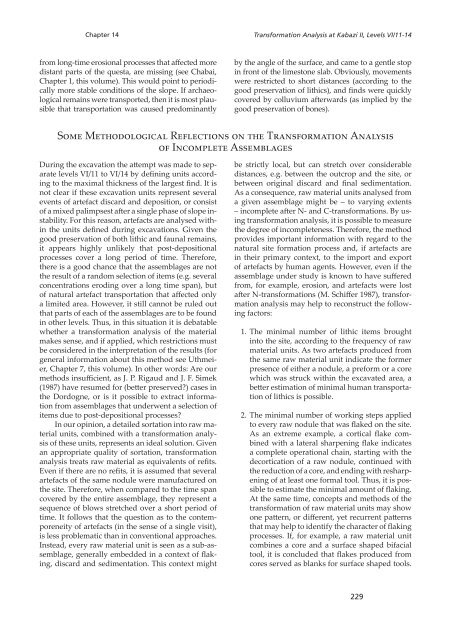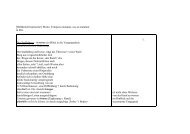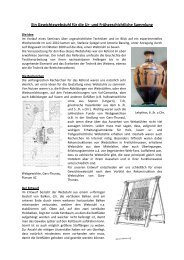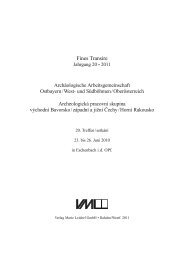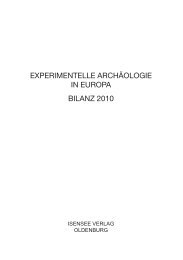Thorsten Uthmeier & Jürgen Richter
Thorsten Uthmeier & Jürgen Richter
Thorsten Uthmeier & Jürgen Richter
Create successful ePaper yourself
Turn your PDF publications into a flip-book with our unique Google optimized e-Paper software.
Chapter 14<br />
from long-time erosional processes that affected more<br />
distant parts of the questa, are missing (see Chabai,<br />
Chapter 1, this volume). This would point to periodically<br />
more stable conditions of the slope. If archaeological<br />
remains were transported, then it is most plausible<br />
that transportation was caused predominantly<br />
Transformation Analysis at Kabazi II, Levels VI/11-14<br />
by the angle of the surface, and came to a gentle stop<br />
in front of the limestone slab. Obviously, movements<br />
were restricted to short distances (according to the<br />
good preservation of lithics), and finds were quickly<br />
covered by colluvium a�erwards (as implied by the<br />
good preservation of bones).<br />
S��� M������������� R���������� �� ��� T������������� A�������<br />
�� I��������� A����������<br />
During the excavation the a�empt was made to separate<br />
levels VI/11 to VI/14 by defining units according<br />
to the maximal thickness of the largest find. It is<br />
not clear if these excavation units represent several<br />
events of artefact discard and deposition, or consist<br />
of a mixed palimpsest a�er a single phase of slope instability.<br />
For this reason, artefacts are analysed within<br />
the units defined during excavations. Given the<br />
good preservation of both lithic and faunal remains,<br />
it appears highly unlikely that post-depositional<br />
processes cover a long period of time. Therefore,<br />
there is a good chance that the assemblages are not<br />
the result of a random selection of items (e.g. several<br />
concentrations eroding over a long time span), but<br />
of natural artefact transportation that affected only<br />
a limited area. However, it still cannot be ruled out<br />
that parts of each of the assemblages are to be found<br />
in other levels. Thus, in this situation it is debatable<br />
whether a transformation analysis of the material<br />
makes sense, and if applied, which restrictions must<br />
be considered in the interpretation of the results (for<br />
general information about this method see <strong>Uthmeier</strong>,<br />
Chapter 7, this volume). In other words: Are our<br />
methods insufficient, as J. P. Rigaud and J. F. Simek<br />
(1987) have resumed for (be�er preserved?) cases in<br />
the Dordogne, or is it possible to extract information<br />
from assemblages that underwent a selection of<br />
items due to post-depositional processes?<br />
In our opinion, a detailed sortation into raw material<br />
units, combined with a transformation analysis<br />
of these units, represents an ideal solution. Given<br />
an appropriate quality of sortation, transformation<br />
analysis treats raw material as equivalents of refits.<br />
Even if there are no refits, it is assumed that several<br />
artefacts of the same nodule were manufactured on<br />
the site. Therefore, when compared to the time span<br />
covered by the entire assemblage, they represent a<br />
sequence of blows stretched over a short period of<br />
time. It follows that the question as to the contemporeneity<br />
of artefacts (in the sense of a single visit),<br />
is less problematic than in conventional approaches.<br />
Instead, every raw material unit is seen as a sub-assemblage,<br />
generally embedded in a context of flaking,<br />
discard and sedimentation. This context might<br />
be strictly local, but can stretch over considerable<br />
distances, e.g. between the outcrop and the site, or<br />
between original discard and final sedimentation.<br />
As a consequence, raw material units analysed from<br />
a given assemblage might be – to varying extents<br />
– incomplete a�er N- and C-transformations. By using<br />
transformation analysis, it is possible to measure<br />
the degree of incompleteness. Therefore, the method<br />
provides important information with regard to the<br />
natural site formation process and, if artefacts are<br />
in their primary context, to the import and export<br />
of artefacts by human agents. However, even if the<br />
assemblage under study is known to have suffered<br />
from, for example, erosion, and artefacts were lost<br />
a�er N-transformations (M. Schiffer 1987), transformation<br />
analysis may help to reconstruct the following<br />
factors:<br />
1. The minimal number of lithic items brought<br />
into the site, according to the frequency of raw<br />
material units. As two artefacts produced from<br />
the same raw material unit indicate the former<br />
presence of either a nodule, a preform or a core<br />
which was struck within the excavated area, a<br />
be�er estimation of minimal human transportation<br />
of lithics is possible.<br />
2. The minimal number of working steps applied<br />
to every raw nodule that was flaked on the site.<br />
As an extreme example, a cortical flake combined<br />
with a lateral sharpening flake indicates<br />
a complete operational chain, starting with the<br />
decortication of a raw nodule, continued with<br />
the reduction of a core, and ending with resharpening<br />
of at least one formal tool. Thus, it is possible<br />
to estimate the minimal amount of flaking.<br />
At the same time, concepts and methods of the<br />
transformation of raw material units may show<br />
one pa�ern, or different, yet recurrent pa�erns<br />
that may help to identify the character of flaking<br />
processes. If, for example, a raw material unit<br />
combines a core and a surface shaped bifacial<br />
tool, it is concluded that flakes produced from<br />
cores served as blanks for surface shaped tools.<br />
229


